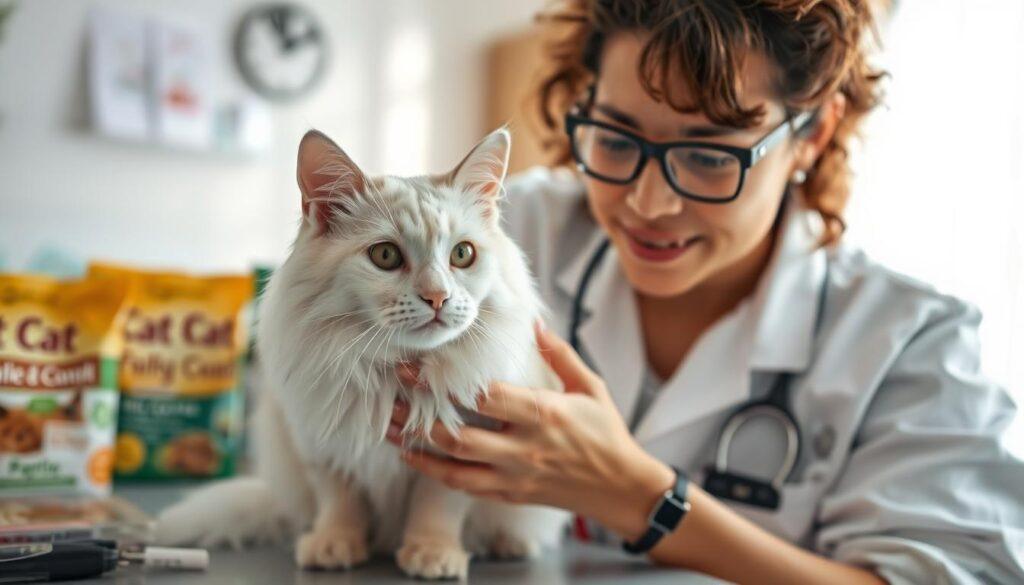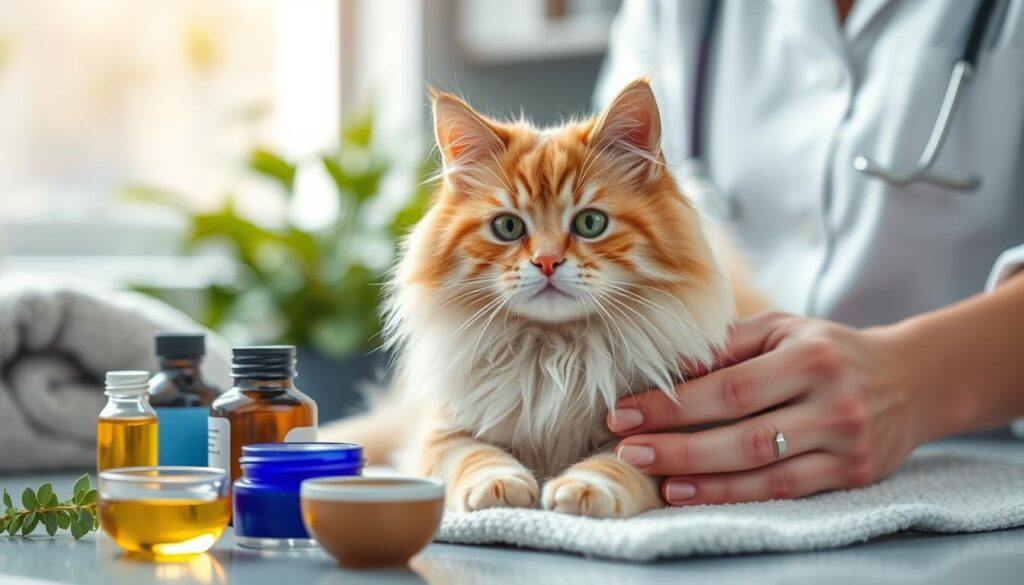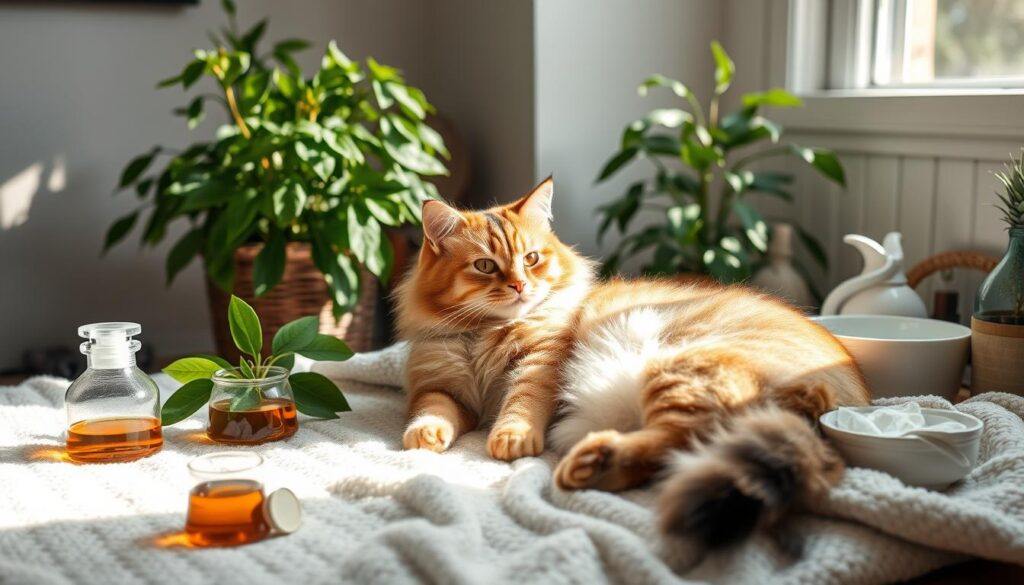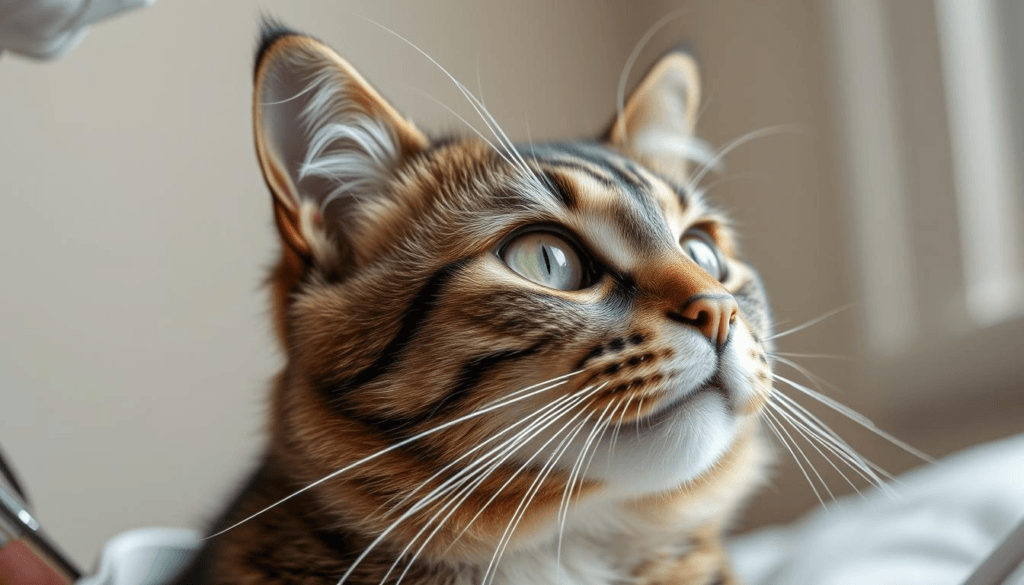As a cat owner, seeing your pet suffer from food allergies is heartbreaking. You desire to provide them with relief and ensure their happiness. Fortunately, understanding the causes and implementing effective solutions can greatly improve your cat’s health. Managing cat food allergies involves dietary changes, monitoring, and a vet’s guidance. Identifying allergens and switching to hypoallergenic diets can alleviate symptoms. With patience and commitment, your cat can overcome allergies and live symptom-free.
This guide delves into cat food allergies, offering you the knowledge to manage your cat’s condition. We’ll discuss common allergens, symptoms, and how to implement an elimination diet. You’ll also learn about natural remedies and strategies to prevent future allergies, empowering you to care for your cat effectively.
Let’s journey together, armed with the latest research and insights, to find effective solutions for cat food allergies. Understanding how to treat food allergies in cats is essential for their well-being. With your love and the right approach, your cat can thrive and live without the burden of allergies. Prepare to enhance your cat’s health and happiness, one purr at a time!
Understanding Cat Food Allergies!
As a cat owner, it’s crucial to know about food allergies in your pet. Though rare, affecting only 1-2% of cats, these allergies can lead to serious health problems. Recognizing common allergens and symptoms is key to your cat’s health.
Common Allergens in Cat Food
Common allergens in cat food include:
- Beef
- Dairy products
- Fish
- Chicken
These ingredients are primary proteins in many commercial cat foods. Food allergies in cats usually start between 2 and 6 years old. It’s vital to watch your cat’s diet and reactions during this period.
Symptoms of Food Allergies in Cats
Signs of a food allergy in cats include:
- Itching and skin irritation
- Hair loss
- Vomiting
- Diarrhea
- Chronic ear infections
- Respiratory issues (less common)
These symptoms can also point to other issues like flea allergies or environmental allergies. Misdiagnosis is common. If you think your cat has a food allergy, see your vet. They may suggest an elimination diet trial to find the allergen.
Diagnosing Food Allergies in Cats!
If you suspect your feline friend may have a food allergy, the first step is to work with your veterinarian. Accurately diagnosing food allergies in cats is challenging. But with patience and the right approach, you can help your furry companion feel better. This will improve their quality of life.

Elimination Diet Trials
One effective method for diagnosing food allergies in cats is through an elimination diet trial. This involves feeding your cat a hypoallergenic diet for several weeks, usually 8-12 weeks. The goal is to identify the allergen causing the reaction. It’s crucial to avoid all other food sources during this trial, including treats and table scraps, to ensure accurate results.
Your veterinarian will recommend a specially formulated hypoallergenic diet to help combat food allergies cats may experience. This diet will contain novel protein sources, such as rabbit or venison, and carbohydrates your cat hasn’t been exposed to before. If your cat’s symptoms improve, you can gradually reintroduce individual ingredients from their original diet. This will help pinpoint the specific allergen.
Allergy Testing Methods
In addition to elimination diet trials, your veterinarian may suggest other allergy testing methods. These tests can include:
- Blood tests: Measuring the levels of antibodies in your cat’s blood can help identify potential allergens.
- Skin tests: Applying small amounts of allergens to your cat’s skin and observing the reaction can help determine the cause of the allergy.
While these tests can provide valuable information, they are not always conclusive. They should be used in conjunction with an elimination diet trial for the most accurate diagnosis.
Choosing the Right Hypoallergenic Cat Food!
Managing your cat’s food allergies starts with the right choice of hypoallergenic cat food. About 10 to 15 percent of cats suffer from allergies. Finding a diet that meets their needs can greatly improve their health and happiness.
Look for cat food with novel proteins like rabbit, duck, or venison. These are less likely to cause allergic reactions than common proteins like chicken, beef, or fish. Also, choose limited ingredient diets to reduce potential allergens.

Consider the quality, cost, and taste of the food when picking a hypoallergenic diet. High-quality options, such as Purina Pro Plan Allergen Reducing High Protein Cat Food or Hill’s Science Diet Sensitive Stomach & Skin Dry Cat Food, provide balanced nutrition. They include essential vitamins, minerals, and omega-3 fatty acids for your cat’s health.
Finding the right hypoallergenic cat food may take some time. Collaborate with your vet to find the best diet for your cat’s allergies and nutritional needs. With patience and effort, you can ensure your cat enjoys a healthy, allergen-free diet.
Implementing an Elimination Diet for Your Cat!
If you suspect your cat has a food allergy, starting an elimination diet is key. This method involves introducing new, hypoallergenic foods slowly. It’s important to watch your cat’s health closely. With time and effort, you can ease their allergy symptoms and boost their health.

Gradually Introducing New Foods
Introducing new foods slowly is crucial to avoid digestive issues. Start by mixing a small amount of new food with their current diet. Gradually increase the new food over 7-10 days. This will help your cat adjust to the new diet. Remember, the elimination diet must be followed strictly for 8-12 weeks. No other treats, supplements, or exposure to other pets’ food is allowed during this time.
Monitoring Your Cat’s Progress
Keep a close eye on your cat’s health during the elimination diet. Use a journal to track any changes in symptoms. This could include itching, skin irritation, or digestive problems. Note any improvements or setbacks for your vet. Also, monitor your cat’s weight. Adjust their food amounts as needed to keep them healthy. With careful observation and dedication, you can help your cat overcome food allergies. This will lead to a happier, healthier life for them.
Supplementing Your Cat’s Diet for Optimal Nutrition!
Managing your cat’s food allergies requires ensuring they get the best nutrition during the elimination diet. Supplementing your cat’s diet with vital vitamins and minerals can fill any nutritional gaps. This support is crucial for their overall health.
Essential Vitamins and Minerals
Cats need a balanced diet rich in key vitamins and minerals to stay healthy. Some essential vitamins for cats include:
- Vitamin A for eye and skin health
- B vitamins for energy metabolism and nervous system function
- Vitamin D for bone and muscle strength
- Vitamin E as an antioxidant to protect cells
It’s important to consult with your veterinarian. They can advise if your cat needs extra vitamin supplements. This will depend on their specific dietary needs during the elimination trial.
Omega-3 Fatty Acids for Skin and Coat Health
Food allergies often show up as skin and coat issues in cats. Adding omega-3 fatty acids to their diet can help. These essential fatty acids have anti-inflammatory properties. They can soothe irritated skin and make their coat shiny and healthy. You can add omega-3s to your cat’s diet with fish oil supplements. Or, choose hypoallergenic cat foods that include these fatty acids. Always check with your veterinarian to find the right dosage for your cat.
Managing Environmental Allergens for Cats!
Addressing food allergies is vital for your cat’s health, but managing environmental allergens is equally crucial. About 60-70% of cats with food allergies also have environmental allergies. This makes it essential to address both for your cat’s well-being.
Common environmental allergens for cats include pollen, dust mites, mold spores, and certain chemicals. These allergens can worsen food allergy symptoms, causing skin issues, respiratory problems, and gastrointestinal distress. By incorporating effective cat food allergy management and reducing your cat’s exposure to these triggers, you can alleviate their discomfort and enhance their health.

To minimize environmental allergens, establish a regular cleaning routine. Vacuum often, focusing on areas where your cat spends most of its time. Using a vacuum with a HEPA filter can effectively trap small particles and allergens. Also, consider investing in an air purifier to remove airborne allergens from your home.
Grooming your cat regularly can also help reduce allergen exposure. Brushing their coat removes loose hair and dander, which can harbor allergens. If your cat is allergic, use hypoallergenic grooming products as recommended by your veterinarian. In some cases, your veterinarian may suggest additional measures. This could include using allergen-resistant bedding or limiting your cat’s access to certain areas. By working closely with your vet and implementing a comprehensive management plan, you can effectively control environmental allergens. This will provide your cat with much-needed relief from allergy symptoms.
Treating Secondary Skin Infections Caused by Allergies!
Cats with food allergies often experience skin irritation and itchiness. This leads to excessive scratching and licking, potentially causing secondary skin infections. It’s vital to act quickly and consult with your vet to find effective treatments.

Topical Treatments and Medicated Shampoos
Topical treatments and medicated shampoos are effective for treating skin infections in cats. These products are designed to soothe irritated skin, reduce inflammation, and eliminate harmful bacteria. When choosing a medicated shampoo, look for chlorhexidine, benzoyl peroxide, or miconazole. These ingredients have antibacterial and antifungal properties. Regular use of these shampoos can help alleviate symptoms and promote healing.
Antibiotics for Severe Cases
For severe skin infections, your vet may prescribe oral or injectable antibiotics. These antibiotics target and eliminate the specific bacteria causing the infection. It’s crucial to follow your vet’s instructions and complete the full course of treatment. This ensures your cat’s skin heals fully and prevents antibiotic resistance.
Remember, treating secondary skin infections is just one part of managing your cat’s food allergies. Collaborating with your vet, identifying allergens, and implementing a balanced, hypoallergenic diet are key. These steps can help your cat achieve optimal skin health and overall well-being.
Using Natural Remedies to Alleviate Allergy Symptoms!
Managing your cat’s allergies can be done gently and effectively with natural remedies. These solutions can be added to your pet’s care routine. They help alleviate symptoms and improve their overall health.

Omega-3 Fatty Acids
Omega-3 fatty acids are a promising natural remedy for cat allergies. Found in fish oil and flaxseed, they have anti-inflammatory properties. These nutrients can reduce allergy symptoms’ severity. Adding omega-3 supplements to your cat’s diet can soothe irritated skin, lessen itching, and promote a healthier coat.
When selecting an omega-3 supplement for your cat, choose high-quality products made for pets. Follow the dosage instructions and consult your vet to ensure it meets your cat’s needs.
Probiotics for Digestive Health
Probiotics for cats also play a key role in managing allergies. They are beneficial bacteria that maintain a healthy digestive balance. Supporting gut health, probiotics boost your cat’s immune function and decrease allergic reactions.
When picking a probiotic supplement, look for one with live, active cultures and is made for feline digestive health. Gradually add the probiotic to your cat’s diet, following the dosage instructions, and watch for their response. Incorporating natural remedies like omega-3 fatty acids and probiotics into your cat’s allergy management plan can offer gentle, effective relief. Always consult with your veterinarian before starting any new supplements to ensure they are right for your cat’s specific needs.
Working with Your Veterinarian to Manage Feline Allergies!
Managing feline allergies can be a daunting task, but you’re not alone. Working with your veterinarian is key to creating an effective plan for your cat’s allergies. This collaboration ensures your cat gets the best care and treatment.

When you visit the vet, share your cat’s symptoms, diet, and any changes in behavior or health. Your vet will conduct a detailed examination. They might suggest allergy tests or an elimination diet to pinpoint the allergens. Then, they’ll craft a treatment plan that fits your cat’s unique needs.
Regular check-ups are vital to track your cat’s progress and adjust their treatment as needed. Feel free to ask questions or express any concerns about your cat’s health. Your vet is committed to guiding and supporting you in managing your cat’s allergies. Your vet may also suggest environmental changes to lessen your cat’s allergen exposure. This could include using hypoallergenic bedding, vacuuming and dusting frequently, and using air purifiers. By making these changes and following your vet’s advice, you can make your home a safer, more comfortable space for your cat.
Preventing Future Food Allergy Flare-Ups in Cats!
Diagnosing and treating your cat’s food allergies is just the first step. It’s vital to take proactive measures to prevent future flare-ups. By sticking to a consistent hypoallergenic diet, regular vet visits, and focusing on preventing food allergies cats may develop, you can keep your cat comfortable and healthy.
Maintaining a Consistent Hypoallergenic Diet
Identifying and avoiding allergens is key. Stick to a hypoallergenic diet to prevent relapses. Always check food labels for allergens to ensure safety. Adhering to a hypoallergenic diet is a long-term commitment. Food allergies affect 10 to 15 percent of cats, with common culprits being chicken, beef, and dairy. A consistent, allergen-free diet can greatly reduce flare-up risks.
Regular Check-Ups with Your Vet
Regular vet visits are crucial for monitoring your cat’s health. Your vet can assess your cat’s condition and adjust treatments as needed. Allergy shots may be recommended for long-term management of atopic dermatitis. These shots help desensitize your cat to specific allergens. Close collaboration with your vet ensures your cat’s health and well-being.
How to Treat Food Allergies in Cats!

Managing food allergies in cats is a significant challenge for both the cat and its owner. Yet, by taking a few crucial steps and adopting long-term strategies, you can effectively manage your cat’s allergies. This ensures a healthier, happier life for your furry friend.
Key Steps to Manage Feline Food Allergies
The first step is to identify the allergens causing the issue. An elimination diet helps you do this by removing potential allergens from your cat’s diet. Monitor their response closely. Once you’ve identified the allergens, work with your vet to create a tailored hypoallergenic diet plan.
Implementing an elimination diet requires patience and dedication. Introduce new, allergen-free foods gradually and monitor your cat’s progress. Keep a journal of symptoms and any changes. Regular updates with your vet are crucial to ensure your cat gets the right nutrition and care.
Long-Term Strategies for a Healthier, Happier Cat
After identifying and eliminating allergens, maintaining a consistent hypoallergenic diet is key. Stick to a specific brand or recipe that suits your cat’s digestive system. Avoid table scraps or treats that could trigger an allergic reaction. Incorporating cat food allergy solutions can help ensure your cat stays healthy and free from allergy flare-ups. Regular vet check-ups are vital for monitoring your cat’s health and catching issues early. Your vet may recommend supplements like omega-3 fatty acids to support your cat’s skin and coat health, which can be affected by food allergies.
By being vigilant and committed to your cat’s long-term well-being, you can manage their food allergies effectively. A balanced diet, proper medical care, and plenty of love and attention will help your cat thrive despite their dietary challenges.
Conclusion!
Treating cat food allergies demands patience, dedication, and a strong partnership with your vet. Understanding common allergens and recognizing symptoms is key. An elimination diet can help pinpoint the allergen causing your cat’s reactions. Choosing hypoallergenic cat food and introducing new proteins gradually is crucial for managing allergies.
Adding essential vitamins, minerals, and omega-3 fatty acids to your cat’s diet supports their health and reduces allergy symptoms. It’s also important to manage environmental allergens and treat secondary skin infections. Natural remedies like probiotics can aid in digestive health and boost the immune system. Every cat is different, and what works for one may not work for another. Collaborating with your vet and persisting in finding the best solutions for your pet is essential. With the right strategy and love, you can overcome the hurdles of treating cat food allergies. This ensures your feline friend leads a healthier, happier life.
Frequently Asked Questions!
Q: What are the most common allergens found in cat food?
A: Common allergens in cat food include beef, dairy, fish, and chicken. These ingredients can trigger allergic reactions in some cats. Symptoms may include itching, hair loss, vomiting, and diarrhea. It’s vital to watch how your cat reacts to certain foods and seek a vet’s advice for a proper diagnosis. Switching to limited-ingredient or hypoallergenic cat food can help manage these allergies effectively. This approach can help identify and manage these allergies more efficiently.
Q: How can I diagnose food allergies in my cat?
A: Diagnosing food allergies in cats requires careful observation and testing. You’ll need to feed your cat a hypoallergenic diet for several weeks. This is to see if their symptoms improve and to identify any allergens. This method is often the most reliable way to pinpoint the problematic ingredient. Alongside diet trials, your veterinarian can perform blood tests and skin tests. These tests help identify the specific cause of your cat’s allergic reactions. It’s essential to consult with your vet for guidance. They can help rule out other health issues that may mimic allergy symptoms. This ensures your cat receives the right treatment for their specific needs.
Q: What should I look for when choosing a hypoallergenic cat food?
A: When searching for hypoallergenic cat food, focus on options with novel protein sources. Ingredients like duck, venison, or rabbit are less likely to cause allergic reactions. Make sure the food avoids common allergens such as chicken, beef, or grains. It’s also important to consider the quality of the ingredients. The cost and your cat’s taste preferences should not be overlooked. This approach ensures your cat gets the balanced nutrition they need while managing allergies effectively. Consulting with your vet for specific recommendations tailored to your cat’s needs can also be beneficial.
Q: How can I successfully implement an elimination diet for my cat?
A: To start an elimination diet, introduce new, hypoallergenic foods gradually. This allows your cat’s system to adjust slowly. Begin by switching their current food to a limited-ingredient or hypoallergenic diet. Continue this for 8-12 weeks. Watch your cat’s health closely for any signs of improvement or recurring symptoms. Keeping a detailed journal of symptoms, health changes, and new foods is essential. Avoid treats, table scraps, or any food that could disrupt the diet during this time. Collaborate with your vet to ensure your cat’s nutritional needs are met. This collaboration is key to identifying any triggers effectively.
Q: What natural remedies can help alleviate allergy symptoms in cats?
A: Natural remedies can help soothe skin irritation in cats. Increasing omega-3 fatty acids reduces inflammation. This can ease skin problems. Adding probiotics supports digestive health and boosts immunity, aiding in managing allergic reactions. Try hypoallergenic or limited-ingredient diets that exclude common allergens. These diets can help alleviate symptoms. Herbal supplements like quercetin, known as “nature’s Benadryl,” may also provide relief by reducing histamine release. Always consult with your veterinarian before introducing new supplements. This ensures safety and efficacy for your cat. Your vet can guide you on the best options for your pet’s specific needs.
Q: How can I prevent future food allergy flare-ups in my cat?
A: Prevent future flare-ups by maintaining a consistent hypoallergenic diet tailored to your cat’s needs. Avoid introducing new foods without consulting your vet, as even small changes can trigger allergies. Regular vet visits are essential to monitor your cat’s overall health and adjust their diet if needed. Keep an eye out for new symptoms like itching, vomiting, or digestive issues, and address them promptly. Providing clean, allergen-free food and water bowls can also help reduce exposure to potential allergens, keeping your cat happy and healthy.
Q: What role does my veterinarian play in managing my cat’s food allergies?
A: Your vet is essential in managing your cat’s food allergies. Regularly update them on your cat’s health. Ask questions and follow their advice for effective treatment and prevention.





I used the food allergy elimination diet, which involved feeding my cat a new protein source or a hydrolyzed protein diet for about 8 to 12 weeks. During that time, I monitored any improvements in symptoms like itching, gastrointestinal issues, or skin irritation. My cat’s comfort and well-being were worth the effort. I found a solution that helped them feel much better. Which made everyone feel better.
Thank you for sharing your experience Kevin! It sounds like your hard work paid off. Watching for those symptoms does takes patience, but it’s worth it when your cat feels better! 😊🐾